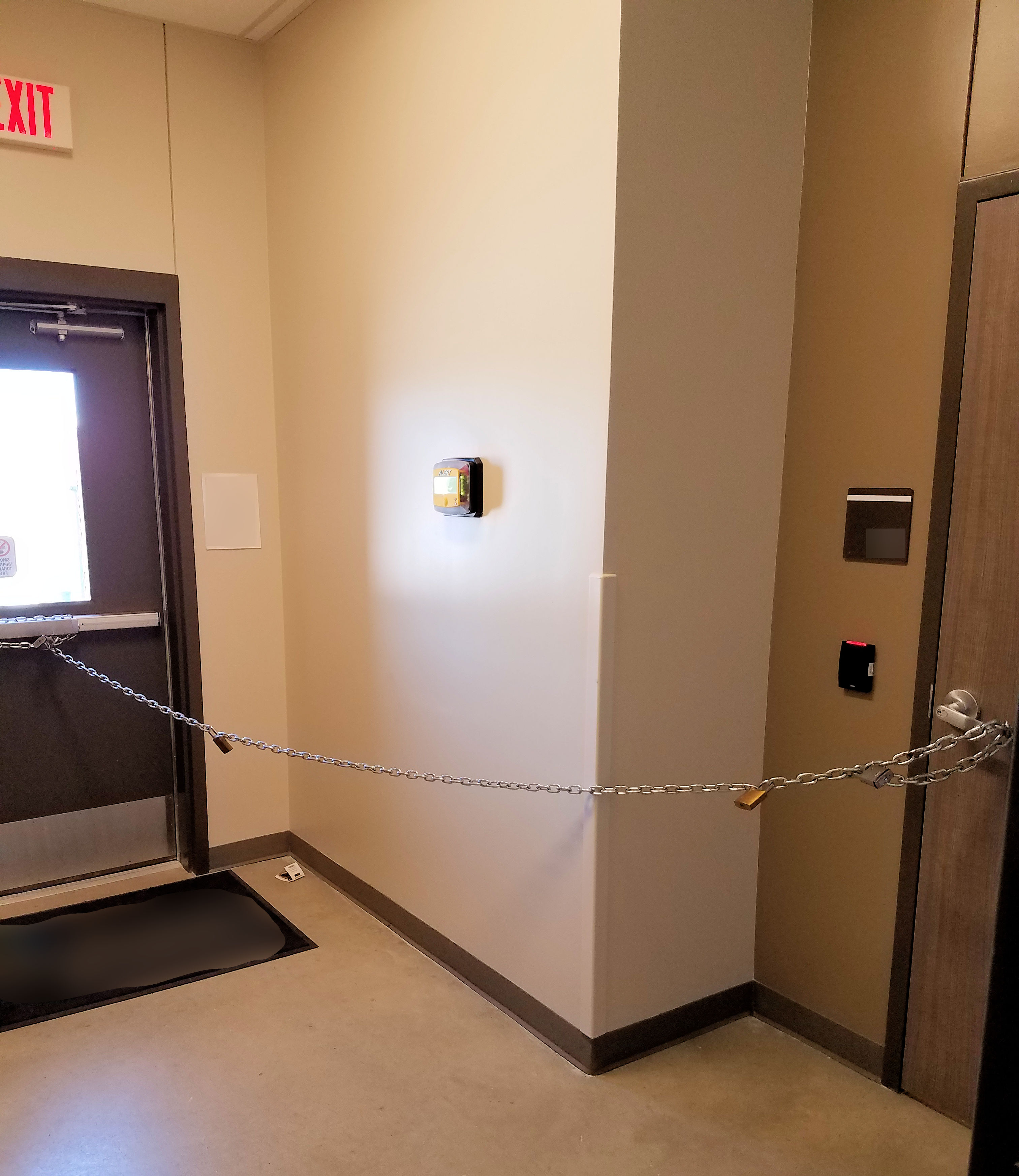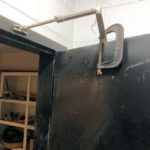There is a lesson behind today’s Fixed-it Friday photo. Upon first glance you see an exterior door locked with padlocks and a chain attached to the lever on an adjacent door. But why?
On the exterior door, panic hardware was installed with fail safe lever trim on the outside. There was a problem with the lever trim – I’m not sure what the problem was exactly – but it left the lever unlocked and the chain was the temporary fix. So why was the lever trim fail safe? Why not fail secure? I would almost never use fail safe trim in an exterior application – it creates a security problem every time there is a loss of power.
Can you think of any reason this door should have fail safe lever trim rather than fail secure?
You need to login or register to bookmark/favorite this content.








Maybe the first installer did not field convert from fail safe to fail secure, then when the alarm access guy got there they found it was set up for fail safe and instead of disassembling the device to convert the electrified lever they just wired it up to work. Granted this is all speculation, but is the only reason I could think of.
That’s giving the alarm access guy a lot of credit that may not be deserved. They usually just wire their card reader and when something doesn’t work, they say the hardware is defective. We then send someone to test the hardware by connecting the hardware directly to a power supply to prove it works fine.
I’m with Lach on this. Most likely a misunderstanding during install and set-up. The only other reason I can think of is this is inside a fenced area and is a secondary egress point out of a that area?
Some one thought it was a fire stairwell and was in the stack for reentry requirements……. 🙂
I like Lachs answer above better!
I can’t believe my eyes but is the exterior door a LH door and the panic strike side towards the hinge? Therefore, no way to lock the door except by the chain method shown.
If the door serves a courtyard whose only exit is through the building.
Good guess, but in that case the panic hardware would usually be on the outside with the doors swinging into the building – if the occupant load of the courtyard was 50 people or more. If it was a lower occupant load the doors could swing toward the courtyard, but the outside lever would always be unlocked unless the AHJ allowed a code modification.
– Lori
the lever on the door has a bad tooth so when the exterior door is opened it will yank the tooth.
🙂
It very easily could be a misinterpretation of the code. I often am asked to specify hardware that is fail-safe, their thinking that it affects egress instead of ingress.
An extreme case of this was when a very high-up AHJ in the city of Seattle was insistent that the exterior doors be fail-safe. The contractors on several projects were forced to retrofit the main exit door panic devices to have fail-safe lever trim.
Hi Eric –
I agree…it happens all the time. People don’t realize that the terminology is only referencing the outside lever (usually) and that the inside lever or panic hardware typically allows free egress.
– Lori
I believe the space is a vestibule and the facility is secured by the proximity card reader next to the interior door. The question in my mind is why the chain?
Hi Dan –
The chain was there because the exterior door was left unlocked due to the fail safe lever trim, and the facility had no way to lock the door. The interior door with the reader leads to a lab.
– Lori
Uh! Maybe they didn’t know the difference, I know your saying sure they did, I wouldn’t be so sure now days
See it all the time with field ordered hardware…add in a rush to get something done and that 16 character part number isn’t looked over carefully!
It is tied into fire alarm system and AHJ requires fail safe for emergency personnel access after alarm is pulled.
It’s a possibility, but most doors with electrified hardware are not required to be fail safe. Electromagnetic locks that are unlocked by a sensor, and doors that facilitate stairwell reentry are the common exceptions to that. But electrified lever trim on an exterior door should not unlock upon fire alarm or power failure.
– Lori
I see this all too often . Mis application of hardware . Failure to understand the terminology of fail safe and fail secure . I usually put it in more simplified terms of fail locked and fail unlocked. It allows those that don’t understand hardware and it’s function to visualize the acutal device and it’s operation
That’s a good idea, David.
– Lori
Maybe it’s a controlled access opening and people don’t want to carry mechanical keys. I get that comment often when I try to schedule a keying meeting. “Everyone will carry fobs so a mech key isn’t needed.” Yes, but what happens when in the event of a power loss? “Just make it fail safe.” I don’t think you realize that means the door will be unlocked. “No one will remember to carry their key”.
A lot of people are getting too reliant on controlled access they don’t even want to deal with actual keys.
Hi Austin –
In this case I think it was just installed out of the box without being changed to fail secure. We are now shipping our electrified trims fail safe or fail secure as ordered.
– Lori
A lot of people are getting too reliant on controlled access they don’t even want to deal with actual keys.
I love this because my keying meetings are so much easier now. “Just key everything alike”.
Is “fail-safe” hardware required to unlock if the supply of power from the utility fails, or only if it has no available source of power? Could the security risks posed in case of power failures be mitigated by supplying everything associated with the locks with power from a battery-backup unit? An extended power failure might result in all the locks releasing, but a battery backup unit could give enough time to put security personnel in place to guard important areas.
It’s not that fail safe hardware is required to unlock, it just unlocks whenever power is removed. There are very few locations where electrified hardware is required to be fail safe. For example, fail safe locks are usually used where stairwell reentry is required, and electromagnetic locks are inherently fail safe. The codes are not 100% clear on whether battery backup is allowed for mag-locks, but here’s an article I wrote about it: https://idighardware.com/2010/12/nfpa-72-on-access-control-2/.
– Lori
What I’ve seen happen is that someone will cut the tailpiece of a rim device cylinder too short and the locking and unlocking ends up at the mercy of the little plastic tailpiece finder that comes with your Von Duprin exit device. What inevitably happens is that someone will turn the key too far causing the plastic piece to tear away, the cylinder tailpiece drops, and your exit device is left in whatever function it made it’s way to.
Interesting!
– Lori
This isn’t a long term fix, this is just a door maintenance tool. The interior lever must be stuck.
I really like the (2) brass medium security quick disconnects and the masterlock brand quick link they’ve used to kludge together 3? 4? pieces of chain to get the great mechanical advantage to be able to rip that lever right off the interior door. Give one good hard tug on the outside door, and you’ve got the equivalent of a 6′ prybar working on that handle.
Way late to this party, but I did supply Fail Safe on an exterior opening some time ago. The opening was the lobby entrance to a college dormitory and it was normally card in. It was originally specified Fail Secure but, during construction, students became locked out of another building when power was disrupted by a passing hurricane. (No battery backup or emergency power, apparently.) At that point it was decided that Fail Safe would be better to allow people to find shelter in such an emergency.